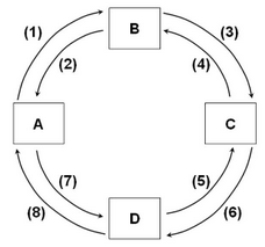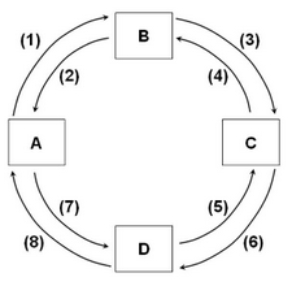A) Which output will be produced?
B) How is the output to be produced?
C) How can the system accommodate change?
D) Who is to receive the output?
F) A) and B)
Correct Answer

verified
Correct Answer
verified
Multiple Choice
The economies of North Korea and Cuba are
A) similar in that they are both basically command systems.
B) similar in that they are both basically market systems.
C) different in that North Korea has a command system, while Cuba has a market system.
D) different in that Cuba has a command system, while North Korea has a market system.
F) B) and C)
Correct Answer

verified
Correct Answer
verified
Multiple Choice
In the resource market,
A) businesses borrow financial capital from households.
B) businesses sell services to households.
C) households sell resources to businesses.
D) firms sell raw materials to households.
F) B) and D)
Correct Answer

verified
Correct Answer
verified
Multiple Choice
The main mechanism that regulates the market system is
A) self-interest.
B) private property.
C) competition.
D) freedom of enterprise and choice.
F) B) and C)
Correct Answer

verified
Correct Answer
verified
Multiple Choice
The major virtues of the market system include all of the following, except
A) it promotes an efficient allocation of resources.
B) it leads to equality in the distribution of income.
C) it provides incentives for greater production and higher incomes.
D) it emphasizes the freedom to pursue self-interest.
F) A) and D)
Correct Answer

verified
Correct Answer
verified
Multiple Choice
Which of the following is not one of the five fundamental questions that an economy must deal with?
A) How will the goods and services be produced?
B) Why should the goods and services be produced?
C) Who is to receive the goods and services produced in the economy?
D) In what ways will progress be promoted?
F) A) and C)
Correct Answer

verified
Correct Answer
verified
Multiple Choice
In a market system, the "What will be produced?" question is ultimately decided by
A) profitability of products.
B) costs of production.
C) workers in the firms.
D) industry analysts.
F) C) and D)
Correct Answer

verified
Correct Answer
verified
Multiple Choice
If a competitive industry is neither expanding nor contracting, we would expect
A) total revenue to be zero.
B) economic profits to be zero.
C) total opportunity cost to be zero.
D) more resources to flow to that industry.
F) A) and D)
Correct Answer

verified
Correct Answer
verified
True/False
According to the circular flow model of the market system, firms get their ability to pay for their costs of production from the revenues that they receive for their products.
B) False
Correct Answer

verified
Correct Answer
verified
Multiple Choice
In a competitive market economy, firms select the least-cost production technique because
A) such choices will result in full employment of available resources.
B) to do so will maximize the firms' profits.
C) this will prevent new firms from entering the industry.
D) "dollar voting" by consumers mandates such a choice.
F) All of the above
Correct Answer

verified
Correct Answer
verified
True/False
Property rights give to some people the right to coerce others into giving up their property.
B) False
Correct Answer

verified
Correct Answer
verified
Multiple Choice
The invisible hand promotes society's interests because
A) individuals pursuing their self-interest will try to produce goods and services that people in society want and are willing to purchase.
B) individuals will produce goods for others out of concern for their fellow human beings.
C) it makes sure that everyone wins from competition in the market.
D) government regulation pushes business into producing the right mix of goods and services.
F) C) and D)
Correct Answer

verified
Correct Answer
verified
Multiple Choice
The market system's answer to the fundamental question "What will be produced?" is essentially
A) "Goods and services that are profitable."
B) "Low-cost goods and services."
C) "Goods and services that can be produced using large amounts of capital."
D) "Goods and services that possess lasting value."
F) B) and C)
Correct Answer

verified
Correct Answer
verified
Multiple Choice
Which of the following best describes the "invisible hand" concept?
A) Ample regulation of business by the government will maximize the public's best interests.
B) The market system works best when resources are free to move from one use to another.
C) The problem of scarcity can best be overcome in a system of mixed capitalism.
D) Self-interest in a market system will automatically promote the public interest as well.
F) A) and C)
Correct Answer

verified
Correct Answer
verified
Multiple Choice
A required element for specialization to lead to an increase in the satisfaction of society's wants is
A) a capitalist economy.
B) exchange and trade.
C) the use of money.
D) a central plan.
F) A) and D)
Correct Answer

verified
Correct Answer
verified
Multiple Choice
Property rights are important because they
A) ensure an equal distribution of income.
B) encourage cooperation by improving the chances of mutually agreeable transactions.
C) guarantee that any exchange will make all parties better off than prior to the exchange.
D) allow the government to control how resources are allocated.
F) All of the above
Correct Answer

verified
Correct Answer
verified
Multiple Choice
Refer to the provided figure. If box A represents households, D the resource market, and C businesses, then flow (8) would represent , while flow (7) would represent _. 
A) goods and services; consumption expenditures
B) consumption expenditures; goods and services
C) resources; money income
D) money income; resources
F) None of the above
Correct Answer

verified
Correct Answer
verified
Multiple Choice
Which of the following is a distinguishing feature of laissez-faire capitalism?
A) public ownership of all capital
B) central planning
C) minimal government intervention
D) a circular flow of goods, resources, and money
F) A) and C)
Correct Answer

verified
Correct Answer
verified
Multiple Choice
In what type of business do the owners bear no personal financial responsibility for the company's debts and obligations?
A) partnerships
B) corporations
C) sole proprietorships
D) in all of the businesses listed in the other answers
F) B) and C)
Correct Answer

verified
Correct Answer
verified
Multiple Choice
Refer to the provided figure. If box A represents households, B the product market, and C businesses, then flow (2) and flow (4) would represent 
A) the flow of labor and other resources.
B) the flow of goods and services.
C) business spending revenues
D) money incomes and consumer spending.
F) C) and D)
Correct Answer

verified
Correct Answer
verified
Showing 221 - 240 of 252
Related Exams